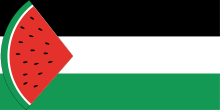Watermelon (Palestinian symbol): Difference between revisions
No edit summary Tags: Mobile edit Mobile web edit |
→See also: watermelon stereotype was removed from the see also section by an IP address with only one edit that is now blocked from eight other pages for some reason. No edit summary. I've added it to a "not to be confused with" template, but others might want to add it back to the see also section. |
||
| Line 1: | Line 1: | ||
{{Short description|Symbol of Palestinian struggle}} |
{{Not to be confused with|Watermelon stereotype}}{{Short description|Symbol of Palestinian struggle}} |
||
[[File:دوار البطيخة جنين.jpg|thumb|236x236px|Watermelon sculpture at a [[roundabout]] in [[Jenin]], [[State of Palestine|Palestine]] (January 2021)]] |
[[File:دوار البطيخة جنين.jpg|thumb|236x236px|Watermelon sculpture at a [[roundabout]] in [[Jenin]], [[State of Palestine|Palestine]] (January 2021)]] |
||
[[File:Palestine Watermelon Flag.svg|thumb|The flag of Palestine with a watermelon symbol replacing the red triangle]] |
[[File:Palestine Watermelon Flag.svg|thumb|The flag of Palestine with a watermelon symbol replacing the red triangle]] |
||
Revision as of 10:46, 21 March 2024



The watermelon is a symbol of Palestinians' public expression in protests and artworks, representing the struggle against the Israeli occupation of the Palestinian .[1][2][3][4][5]
Origins
The Palestinian flag, coloured in the Pan-Arab colors of red, green, white and black, has historically been banned at times in Israel, leading to the locally-grown and similarly-coloured watermelon taking its place in Palestinian iconography as an alternative for decades.[6] Following the 1967 Six-Day War, Israel banned the display of the Palestinian flag and its colours in the Gaza Strip and the West Bank, and annexed East Jerusalem, with the Israeli army arresting anyone who displayed it.[7][8]
In 1993, as part of the Oslo Accords, Israel lifted the ban on the Palestinian flag.[9] At the time, The New York Times claimed "young men were once arrested for carrying sliced watermelons",[10] but Palestinian artist Sliman Mansour has cast doubt on the validity of these claims. He remembers a conversation about it, but does not recall any actual watermelon iconography being used until 2007, when Khaled Hourani created an image for a "Subjective Atlas of Palestine" project. Other artists who have used the watermelon include Sarah Hatahet, Sami Boukhari, Aya Mobaydeen and Beesan Arafat.[11]
See also
- List of national symbols of Palestine
- Kherson watermelon – Symbol of Ukrainian resistance to Russia
- Freedom pineapples – Political response to Chinese import ban
References
- ^ Holtermann, Callie (2023-12-27). "Why the Watermelon Emoji Is a Symbol of Support for Palestinians". The New York Times. Retrieved 2024-01-05.
- ^ "Watermelon: A slice of Palestinian resistance". Middle East Eye. 17 August 2022.
- ^ Sharon, Jeremy (21 June 2023). "Activists use watermelons to protest police crackdown on Palestinian flags". The Times of Israel.
- ^ Weldali, Maria (4 August 2021). "Watermelon becomes symbol of Palestinian existence, resistance". Jordan Times.
- ^ Hisham, Passant (19 October 2023). "How the watermelon symbolizes Palestinian resistance". Kuwait Times.
- ^ Berger, Miriam (12 July 2021). "Why Palestinians are uniting around watermelon emoji". Washington Post.
- ^ Sella, Adam (31 August 2023). "The fruits and vegetables of Palestine and their significance". Al Jazeera.
- ^ Chaves, Alexandra (30 May 2021). "How the watermelon became a symbol of Palestinian resistance". The National.
- ^ Syed, Armani (20 October 2023). "How the Watermelon Became a Symbol of Palestinian Solidarity". TIME.
- ^ Kifner, John (1993-10-16). "Ramallah Journal; A Palestinian Version of the Judgment of Solomon". The New York Times.
In the Gaza Strip, where young men were once arrested for carrying sliced watermelons—thus displaying the red, black and green Palestinian colors—soldiers stand by, blasé, as processions march by waving the once-banned flag
- ^ Chaves, Alexandra (2021-05-30). "How the watermelon became a symbol of Palestinian resistance". The National. Retrieved 2023-11-19.
